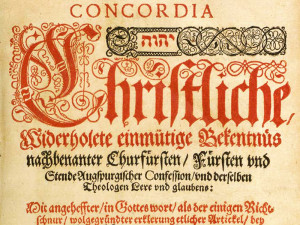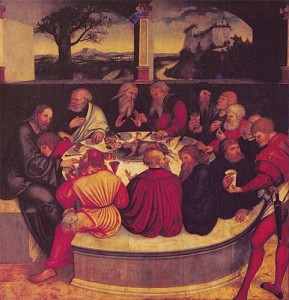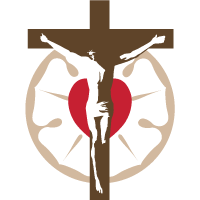by Rev. Mark Bestul
 As my congregation’s Book of Concord study group hears me speak of the contents of the Formula of Concord, they might hear the expression “Articles VII and VIII.” Both historically- and theologically-speaking, seeing these two articles together is proper and useful. They almost serve as “A and B” of the same conversation, two sides of the same coin. Together these articles perhaps make up the ‘heart’ of the Formula of Concord. Concordia: The Lutheran Confessions says in its summary of the historical controversies of the mid-1500s: “In several respects, these two articles are the most important in the Formula of Concord.”[i] More strongly worded, Bente’s Historical Introductions to the Book of Concord describe the couplet of articles this way:
As my congregation’s Book of Concord study group hears me speak of the contents of the Formula of Concord, they might hear the expression “Articles VII and VIII.” Both historically- and theologically-speaking, seeing these two articles together is proper and useful. They almost serve as “A and B” of the same conversation, two sides of the same coin. Together these articles perhaps make up the ‘heart’ of the Formula of Concord. Concordia: The Lutheran Confessions says in its summary of the historical controversies of the mid-1500s: “In several respects, these two articles are the most important in the Formula of Concord.”[i] More strongly worded, Bente’s Historical Introductions to the Book of Concord describe the couplet of articles this way:
Articles VII and VIII of the Formula of Concord, too, reassert Luther’s doctrines on the Lord’s Supper and the person of Christ…which perhaps more than any other serve as the acid test whether the fundamental attitude of a church or a theologian is truly Scriptural and fully free from every rationalistic and enthusiastic infection.[ii]
Why such passion for these articles? These articles are a response to the twenty years that followed Luther’s death, in which Crypto-Calvinism subtly but aggressively attacked the genuine Lutheran understanding of the Lord’s Supper and the Person of Christ and nearly drove out the purity of the Gospel from this cradle territory of the Reformation (For a two-page introduction to the history, read the summary on pp. 468-470 in Concordia: The Lutheran Confessions. Or, to hear it in the confessors’ own words, read paragraphs 1-4 in the Solid Declaration).
We’ve already considered Article VII in these blog articles, but to understand the full picture we must also consider Article VIII. In fact, the Epitome’s introduction to Article VIII even appeals to the intricate relationship between the two:
 From the controversy about the Holy Supper a disagreement has arisen between the pure theologians of the Augsburg Confession and the Calvinists. The Calvinists have also confused some other theologians about the person of Christ and the two natures in Christ and their properties.[iii]
From the controversy about the Holy Supper a disagreement has arisen between the pure theologians of the Augsburg Confession and the Calvinists. The Calvinists have also confused some other theologians about the person of Christ and the two natures in Christ and their properties.[iii]
So, to defend against Calvinistic rationalism and to properly appreciate the article on the Lord’s Supper, we must also properly appreciate the confession of the communication between the two natures in the one Person of Christ, for we cannot know what it is we receive in the Supper if we do not know what the Gospel teaches about the Christ who is the Supper. Thus, a brief study of Article VIII:
1. Calvinism’s teaching regarding the person and natures of Christ and arguments against the Lutherans’ confession revived the ideas of four ancient heretics: Nestorius, Eutyches, Arius, Marcion. Read the simple description of their four errors (Epitome, 20-23) and consider that much of Calvinism’s errors (and many other errors of our day) are a reminder of the saying, “Those who do not learn from history are doomed to repeat it!”[iv]
2. Read Solid Declaration’s paragraphs 20-21 (p. 584) and 24-27 (p. 586). How does the misunderstanding about the personal union and communion of the natures compromise and threaten one’s ability to confess the Incarnation and the second article of the Apostles’ and Nicene Creeds? Might we say that it is very possible for a Lutheran and a Calvinist to both speak these creeds and yet mean something completely different by the same words? How necessary a defense of the Truth is the Formula of Concord!
 3. Read paragraphs 29-30. How is Article VII on the Lord’s Supper brought back into focus here, and why (against Calvin’s ‘magisterial’ use of reason) is it important for the confessors to write that “In this personal union the two natures have such a grand, intimate, indescribable communion that even the angels are astonished by it”?
3. Read paragraphs 29-30. How is Article VII on the Lord’s Supper brought back into focus here, and why (against Calvin’s ‘magisterial’ use of reason) is it important for the confessors to write that “In this personal union the two natures have such a grand, intimate, indescribable communion that even the angels are astonished by it”?
4. To attempt to explain the communication of natures in a way that will satisfy, the Formula includes three headings. Let’s see if we can understand each:
– In Christ two distinct natures exist and remain unchanged/unconfused in their natural essence and properties. Yet, in the one person, the proper attribute of one nature is attributed to the entire person. (Paraphrase of para. 36)
Question: How can this be illustrated by the Gospel record of Jesus walking on water, passing through the door, or being born of Mary, or dying on a cross? Did just one nature do these things, or did ‘the whole Christ’?
– In fulfilling Christ’s office, His Person does not act and work in, with, through, or according to only one nature. Instead, “one nature works in communion with the other what is a property of each.” (Paragraph 46-47)
Question: Is the title “Redeemer” to be understood of just the humanity or just the divinity of Jesus, or of the entire person? What of the title “Good Shepherd” or “High Priest”? When Jesus says, “I am the good shepherd. The good shepherd lays down his life for the sheep,” are we to suddenly attribute this only to the human nature because the divine nature can’t (of its own attributes) die? How dangerous, if we do not rightly confess the Person of Christ!
– “However, it is a much different thing when the question, declaration, or discussion is about whether the natures in the personal union in Christ have nothing else or nothing more than their natural, essential properties” (para. 48).
Question: Did the divine nature change when God became flesh? Does the human nature lose its “human-ness” by being exalted with the divine nature, as if Jesus ‘shed’ his humanity when he ascended into heaven? By no means! Doesn’t Jesus himself say, “If I go and prepare a place for you, I will come again and will take you to myself”?[v] Yet, isn’t the human nature truly exalted to share in the properties of the divine, so that Jesus can promise, “All authority in heaven and on earth has been given to me… And behold, I am with you always, to the end of the age”?[vi]
5. How do verses like 1 John 1:7 – “the blood of Jesus His Son cleanses us from all sins” – testify to the incomprehensible “two natures, yet one Christ” truth of Jesus? Does the divine nature (by its own attributes) have blood? Does the human nature (by its own attributes) have the power to cleanse the world from sin? And yet, is not the one Christ referred to as “Jesus His Son”?
 6. Read paragraphs 27-35 of the Athanasian Creed (the paragraphs are numbered on p. 319-320 of Lutheran Service Book). Consider especially these words, “…equal to the Father with respect to His divinity, less than the Father with respect to His humanity. Although he is God and man, He is not two, but one Christ.”[vii] Now, read Solid Declaration, 61 (p. 591). How is Formula of Concord VIII a great defense of the Athanasian Creed and a solemn reminder of how ancient is the error advanced by Calvinism, and how constant is the vigilance needed to defend against resurfacing errors?
6. Read paragraphs 27-35 of the Athanasian Creed (the paragraphs are numbered on p. 319-320 of Lutheran Service Book). Consider especially these words, “…equal to the Father with respect to His divinity, less than the Father with respect to His humanity. Although he is God and man, He is not two, but one Christ.”[vii] Now, read Solid Declaration, 61 (p. 591). How is Formula of Concord VIII a great defense of the Athanasian Creed and a solemn reminder of how ancient is the error advanced by Calvinism, and how constant is the vigilance needed to defend against resurfacing errors?
7. The analogy of ‘glowing iron’ (para. 66) is used to speak of the exaltation of the human nature of Christ. How is this analogy useful when we look to the Lord’s Supper (para. 79) and Christ’s glorious promise, “This is My body…. This is My blood”?
One of the great theological descriptions of Jesus may be the phrase “the God-Man.” Perhaps after this study, we can learn to appreciate that such a phrase is not merely meant to be ‘creative sermon-speak’, but is meant to confess a most profound and glorious truth, a truth on which the entire Gospel rests! – “I believe that Jesus Christ, true God, begotten of the Father from eternity, and also true man, born of the virgin Mary, is my Lord, who has redeemed me…”[viii]
The Rev. Mark C. Bestul is pastor of Calvary Lutheran Church in Elgin, Ill.
[i] Concordia: The Lutheran Confessions, Second Edition. CPH: 2006, p. 469.
[ii] Bente, F. Historical Introductions to the Book of Concord. CPH: 1921 (reprint 1965), p. 172.
[iii] FC, Ep. VII, 1.
[iv] The saying is attributed to George Santayana, The Life of Reason, 1905.
[v] John 14:3
[vi] Matthew 28:18, 20
[vii] Athanasian Creed, 31-32.
[viii] Small Catechism, II, II.
